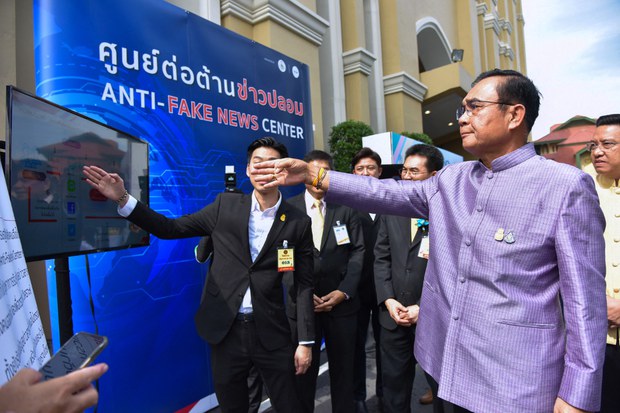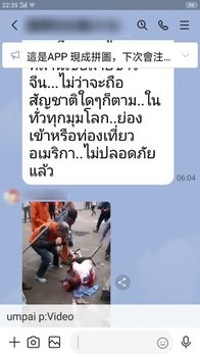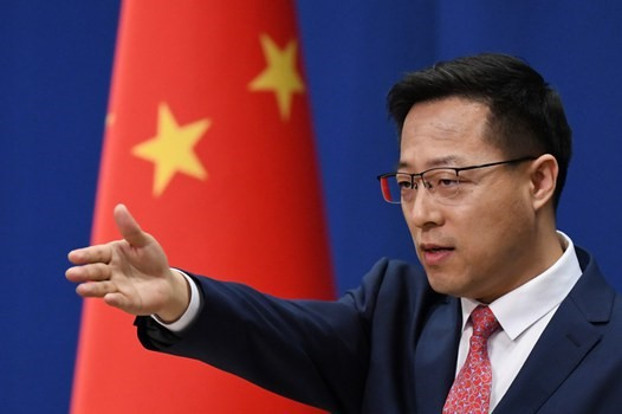Thailand Susceptible to China’s Information Warfare, Experts Say
2021.05.13
 Thai Prime Minister Prayuth Chan-O-Cha (right), attends the launching of the anti-fake news center at the Government House in Bangkok, Oct. 29, 2019.
Thai Prime Minister Prayuth Chan-O-Cha (right), attends the launching of the anti-fake news center at the Government House in Bangkok, Oct. 29, 2019.
Updated at 9:41 p.m. ET on 2021-05-19
By the time video scenes of a brutal prison riot in Ecuador earlier this year reached Asia, the video’s caption had been changed and read, “American Blacks and Whites in California Killing Chinese,” and the clip went viral.
Disinformation like that video, doctored to promote anti-U.S. hatred, is growing in Thailand, media researchers say.
Chinese narratives, whether fake news or state-sponsored propaganda, are gradually seeping into Thai media, academia, and political and business circles, and people from different sectors in Thailand are expressing concern over the phenomenon, experts said.
In the violent video, an Asian man is seen lying on the ground covered in blood and with his face wrenched in pain. Dozens of Spanish-speaking men attack him with bats and sticks, beating him in broad daylight.
No source is cited in the video, which was described in the post as a hate crime against Asians in America, and went viral on social media platforms. Since mid-April, it has been shared widely in Southeast Asian chat groups and on Taiwanese and Chinese social media and instant messaging apps.
The common theme on all the comment threads was: “What’s wrong with the United States?”
After reviewing messages circulating in Chinese WeChat groups; chat groups on Line, the instant message app popular in Asia; and Facebook groups, a reporter for Radio Free Asia, a sister entity of BenarNews, found that the video had targeted audiences in China, Taiwan and Southeast Asia with inflammatory anti-U.S. captions.
“America is out of order! In California, U.S.A., blacks and whites are killing Chinese. Forward this video all over China!” read one.
“A Chinese lost his life meaninglessly, but our country is still trying to please the U.S. for favors,” said another.
“Time for Chinese in the U.S. to wake up. Escape from America as soon as possible. Return to China or emigrate to a Southeast Asian country – the sooner, the better,” said yet another.
Lilly Lee, an independent researcher who studies Chinese Communist Party (CCP) information warfare, said the distorted video looks like a classic example of it.
"Like other films we have seen that are part of the CCP's information wars, this film seeks to push the idea that democracy isn't a good way to govern a country or its people, either by singing China's praises or by portraying chaotic events in the United States," she told RFA.
"We have come across two main narratives in the course of our research. One tries to use China's handling of the coronavirus pandemic to show the superiority of China's system of governance over those of Western countries. The other makes use of incidences of anti-Asian racist attacks in the U.S. to serve their propaganda aims," Lee said.
"These reports are about 30 percent true and 70 percent fake news," she added.
These doctored messages and graphic videos have stirred up significant reactions in the Chinese community in Thailand and also translated into the Thai language.
“Facebook groups and Line are the most popular sources of information in Thailand, especially for the older generations,” said Teeranai Charuvastra, a Bangkok-based journalist and board member of the Thai Journalists Association.
Over the past year, distorted “anti-America” and “Hate Americans” videos have become common in Thailand, he said, noting that while sophisticated younger audiences were unlikely to buy stories like these, older people were more susceptible to media manipulation.

From Russia to Southeast Asia via China
After investigating the source of the video and its paths of transmission, RFA found that what the video had captured was a prison riot in Ecuador on Feb. 23, and it had been uploaded to Twitter by an official of the Ecuadorian Ministry of Justice.
On March 14, the video was shared on Russian instant messaging software and on Telegram. By late April, the video had surfaced on instant messaging software and social media in China, Taiwan and Southeast Asia.
The video also appeared on Reddit, a U.S. forum, where it was mistakenly described as a violent incident in Los Angeles. However, the account that uploaded the video has since been deleted.
Lee said that while Russia’s information warfare is largely operated by government agencies, China’s disinformation work is diffuse, and often delegated to various departments or outsourced to private contractors. Attribution is often difficult because of the wide range of actors involved.
Chinese officials did not respond to request for comment on the Thai fake news campaign. Foreign ministry spokespersons have responded to previous accusations that China spreads disinformation by saying the country is a victim of fake news, not a perpetrator.
A September 2020 report by the U.S.-based Council on Foreign Relations said otherwise.
“Beijing uses large numbers of fake social media accounts to push its messages. It has increasingly relied on the types of trolls and bots Russia has utilized. Chinese diplomats amplify spin and outright false messages, and big Chinese state media outlets push the government’s stories.”
And in March, the most famous of the aggressive official Twitter accounts of China’s “Wolf Warrior” diplomats – that of foreign ministry spokesman Zhao Lijian – tweeted a conspiracy theory suggesting that the coronavirus originated in the U.S. Zhao also stirred controversy in late 2020 when he shared a fake image of an Australian soldier killing an Afghan child.
In Taiwan – a prime target of information warfare aimed at inducing the democratic island to accept unification with the communist mainland – awareness of China’s campaign is high, fact-checking mechanisms are being improved, and the Ecuador video did not attract much reaction.
But the prison riot video that barely caused a ripple in Taiwan ignited passions in Thailand, where it went viral.
The longer game
Thailand was fertile ground for the disinformation video because conspiracy theories about the U.S. were already circulating widely, amid efforts to discredit a student-led movement that mounted a huge wave of pro-democracy protests following dissolution of a progressive political party favored by younger Thais, in February 2020.
Social media disinformation campaigns said the Thai students were incited by Washington, while more outlandish stories alleged Western-led collusion between the Thai student movement and the 2019-20 Hong Kong pro-democracy movement, whose leading activists were branded Western puppets by China’s online troll army.
In August 2019, Twitter announced it had banned 936 accounts originating within China that “were deliberately and specifically attempting to sow political discord in Hong Kong, including undermining the legitimacy and political positions of the protest movement on the ground.”
The U.S. tech giant said it made the decision based on “reliable evidence to support that this is a coordinated state-backed operation.” The 936 frozen accounts followed the proactive suspension of “a larger, spammy network of approximately 200,000 accounts,” it added.
Teeranai, the Thai journalist, said that “the most unfortunate thing is that these infowars are very distracting.
“The danger of this misinformation and disinformation is that they scandalized the activists, who in turn lost their own credibility and the general public’s trust in the movement,” he said.
Beyond the fake news campaigns, analysts in Thailand are also concerned about the longer game China is playing to influence public opinion: the expansion of CCP-owned media in Thailand.
Chinese official media are required to demonstrate strict loyalty to the CCP and to Chinese President Xi Jinping. In the 2021 World Press Freedom Index released by Reporters Without Borders, a press-freedom watchdog, China ranked near the bottom, above Turkmenistan, North Korea and Eritrea, while the number of journalists detained in China is the largest in the world.
In 2015, the Chinese government made “media and information cooperation” with the 10-member Association of Southeast Asian Nations (ASEAN) an essential part of the One Belt, One Road initiative, Xi’s signature global infrastructure program to support trade with China.
In the following years, through mergers and the acquisition of Thai media outlets or through signing MOUs, China began providing free content to TV stations in Thailand from party-controlled outlets Xinhua News Agency and China Central Television (CCTV).

By 2020, Thai media fell under Beijing's influence when covering reports regarding the source of the COVID-19 pandemic, in at least one case running a conspiracy theory pushed by CCTV’s global arm, CGTN.
“Some Thai media just put the conspiracy theory generated by the Chinese state media as news reports. For example, ‘Bombshell Report: The Coronavirus May Have Come from American Soldiers.’ Such so-called news reports did not verify the news sources. They also ignored the fact that the source of information came from Chinese authority-controlled, state-run media,” Teeranai said.
James Gomez, director of the Thai think tank Asia Center, said that compared with Taiwan and Japan, where citizens are on high alert against disinformation and misinformation from foreign powers, in Thailand, the public lacks the ability to identify information from China, while the government does nothing to counter Chinese public opinion influence efforts.
“Thai government agencies and elites are closely aligned with China in order to gain economic, military, or political benefits,” Gomez said.
He is concerned that diversified voices are being muffled in Thailand and fears this will take a toll on a civil society already under pressure from authoritarian military leaders.
“I think if the trend continues, there will be no room left for freedom of expression in Thai society,” Gomez said.
This story was updated to add new quotes.







